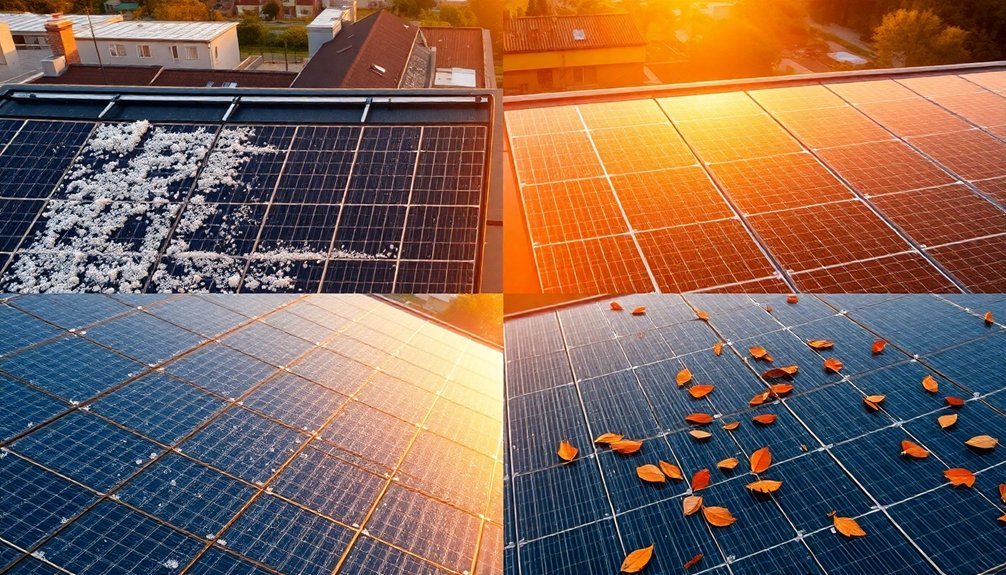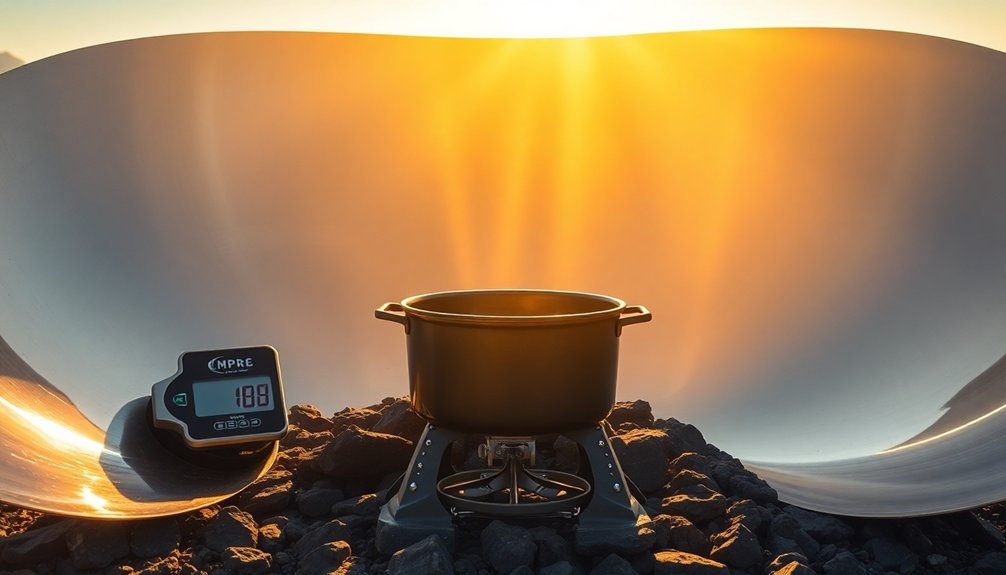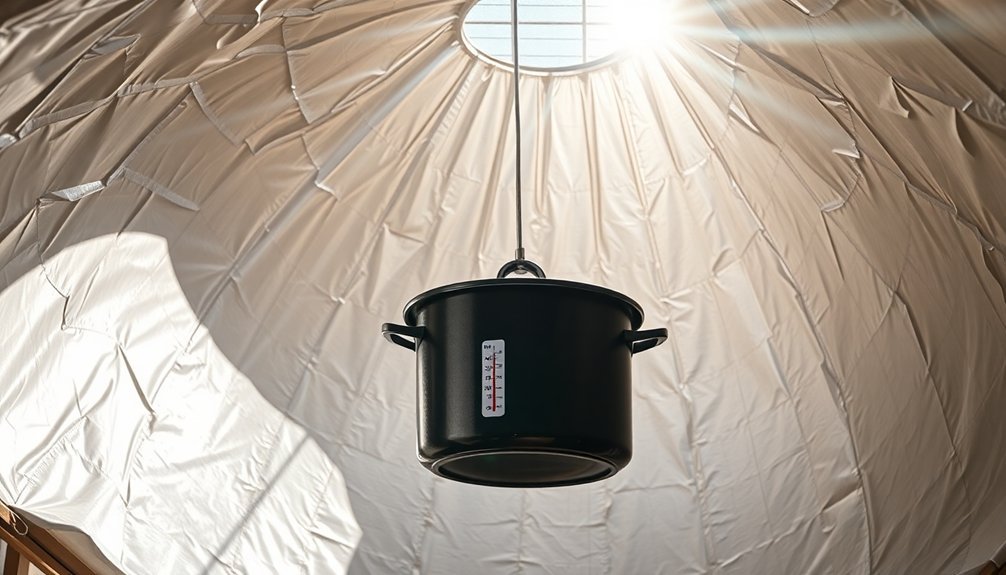Maximize your reflector's power by adjusting its position throughout the year. In winter, angle it down 15° for a 1.8x gain, while summer requires a 14° upward tilt for 3.0x enhancement. Keep your reflector nearly horizontal during spring and fall equinoxes to achieve a 2.2x boost. Clean regularly with appropriate solutions – isopropyl alcohol mix in winter and vinegar solution in spring – to maintain 0.8 reflectance. Don't forget to monitor weather conditions and have protective measures ready. These strategic adjustments can boost your solar energy output by up to 75%, and there's even more you can do to optimize your setup.
Seasonal Reflector Positioning Guide

When it comes to maximizing your reflector's performance throughout the year, proper seasonal positioning is critical.
During winter solstice, angle your reflector down about 15 degrees to achieve a noon gain of 1.8. You'll want your reflector wider than the collector for best results.
As you move into spring, you'll need to adjust for vegetative growth by setting reflectors to a narrow position. Intense penetrating light is crucial during this stage to encourage proper branching development.
Keep your light source farther away to maintain cooler leaf temperatures and prevent stretching.
During summer solstice, position your reflector 14 degrees above horizontal for a noon gain of 3.0.
At equinoxes, set your reflector nearly horizontal for a 2.2 gain.
Remember to keep the tilt lower than the meridian transit altitude to avoid shading your PV panels.
Weather Impact Management Tips
While ideal reflector positioning helps maximize performance, weather conditions can markedly impact your setup's effectiveness.
Research shows that using aluminum reflectors can significantly boost your system's energy output compared to setups without reflectors.
You'll need to monitor forecasts regularly and take protective measures during severe weather events to safeguard your equipment.
- Set up weather alerts on your phone to receive notifications about approaching storms, high winds, or extreme temperatures that could affect your reflector.
- Keep emergency supplies nearby, including protective covers and tie-downs for your equipment.
- Create a quick-response plan for securing or dismantling your reflector when severe weather threatens.
- Document how different weather conditions affect your reflector's performance to refine your management strategy.
Don't forget to integrate local climate data into your planning – it'll help you anticipate seasonal changes and adjust your setup accordingly.
During extreme conditions, it's better to temporarily disable your reflector than risk damage.
Optimal Angle Adjustments By Month

Since reflector performance varies considerably throughout the year, you'll need to make precise monthly angle adjustments to maximize your system's efficiency.
At 40° latitude, you'll want to maintain your reflector at 90° during summer months, especially July, when this angle delivers up to 75% gain.
For spring and early fall, you can keep the same 90° angle, as it's particularly effective during these seasons due to the sun's higher position. However, you'll need to adjust to between 90° and 100° during winter months.
If you're at 45° north latitude, aim for 90° in May for a 74% gain, and either 90° or 95° in January.
Remember to take into account your reflector's length when making adjustments, as longer reflectors can achieve up to 51% gain in winter.
Regular cleaning and maintenance of your reflector surface will help maintain a reflectance of 0.8 for optimal performance throughout the seasons.
Reflector Maintenance Through Seasons
To maintain peak reflector performance throughout the year, you'll need to adjust your cleaning and maintenance routines based on seasonal challenges.
Winter demands extra attention to dust from indoor activities, while spring requires frequent cleaning due to increased pollen levels.
Your seasonal maintenance checklist should include:
- Clean reflectors with a 50/50 mix of 70% isopropyl alcohol and RO water during winter to prevent mineral buildup.
- Switch to a 1:100 vinegar solution in spring for certain reflector types.
- Inspect for damage after storms, particularly during seasonal changes.
- Monitor humidity levels to prevent condensation issues.
Don't wait until you notice reduced light output – regular cleaning prevents up to 20% light loss.
Always use microfiber cloths and avoid tap water to protect your reflector's surface.
Performance Boosting Seasonal Techniques

As the seasons change, you'll need to adapt your reflector's configuration to maximize its performance throughout the year. You can boost your solar collection from 500 to 1000 watts per square meter by fine-tuning your reflector's angle and orientation.
| Season | Reflector Angle | Performance Focus |
|---|---|---|
| Winter | 0-10° above horizon | Maximum light capture |
| Spring | 15-25° tilt | Balanced efficiency |
| Summer | Latitude-based | Direct sun enhancement |
| Fall | 20-30° tilt | Transitional adjustment |
For best results, adjust your reflector monthly rather than seasonally. You'll achieve up to 28.7% more annual gain with regular adjustments. Keep your reflector's length proportional to your PV module for peak efficiency, and make sure your reflector faces south when using east-west elongated collectors. This setup can enhance your winter light gathering power by up to 70%.
Frequently Asked Questions
How Does Reflector Material Choice Affect Long-Term Durability and Performance?
Your choice of reflector material greatly impacts longevity and efficiency. You'll get better durability from silvered-glass mirrors with protective coatings, while metallic reflectors like aluminum can corrode faster and lose reflectance.
Can Reflectors Be Safely Installed on Existing Rooftop Solar Installations?
Yes, you can safely retrofit reflectors on existing rooftop solar systems, but you'll need to guarantee proper installation that maintains worker access, follows OSHA standards, and doesn't create tripping hazards or structural concerns.
What Safety Precautions Should Be Taken When Adjusting Reflectors at Heights?
You'll need secure scaffolding, a safety harness, and non-slip shoes when working at heights. Don't adjust reflectors alone, and always maintain three points of contact while climbing. Use safety-rated equipment.
How Do Different Reflector Shapes Compare in Terms of Energy Gain?
You'll get the best energy gains from flat reflectors, which can boost output by up to 60%. While parabolic reflectors excel at focusing energy, they're less practical, and convex shapes offer minimal improvement overall.
Are There Specific Insurance Considerations When Adding Reflectors to Solar Systems?
You'll need to update your property damage coverage to include reflectors as equipment, guarantee liability protection against third-party claims, and verify your contractor's insurance. Don't forget to check local regulations for compliance requirements.
In Summary
You'll get the most from your reflector by adapting its position throughout the year and staying on top of maintenance. Don't let changing seasons diminish its performance – instead, use them to your advantage. Keep those angles optimized, clean your equipment regularly, and protect against weather damage. With proper seasonal adjustments and care, your reflector will deliver peak performance all year round.





Leave a Reply